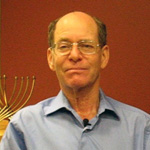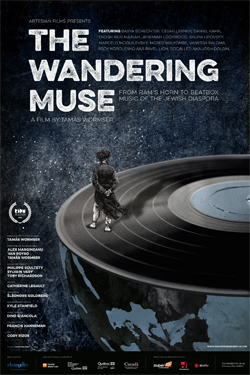By Stanley Tiger

 SAN DIEGO — At the request of my brother, who had worked with filmmaker Tamás Wormser, I received via airmail a DVD of The Wandering Muse. All I knew is that it was a) about Jewish music, b) that I love Jewish music and c) beyond that, I knew little else.
SAN DIEGO — At the request of my brother, who had worked with filmmaker Tamás Wormser, I received via airmail a DVD of The Wandering Muse. All I knew is that it was a) about Jewish music, b) that I love Jewish music and c) beyond that, I knew little else.
After opening the customs cleared package, I saw what looked like a Chassid standing on a flying saucer in the midst of a journey through outer space. Upon closer look, he was standing on a vinyl record – a most imaginative visual. Next step, I read the description on the box, but still could not discern where he was going with this piece.
A couple of days later, I placed it in my player – and in the first ten minutes of watching, I still did not have much of an idea where it was going – but, the film was young and I continued watching. It did have lovely animated watercolor artworks at the opening.
About ½ way – around the 45 minute point – I had to stop the film. I found myself so deeply moved that I needed to take a moment to catch my breath due to a sudden revelation. It hit me like a ton of bricks! (More specifically, bricks of soft cream cheese, rather than the red clay kind.)
What I was watching was a film on varieties of Jewish religious experience – it was such a profound revelation, coming suddenly yet slowly. I was witnessing a range of Jewish expression in music, words and in the lifestyle of wandering musicians. These included individuals peripherally committed to their faith and scenes of the most intensely devout of Chassidism.
The film introduces us to about a dozen different musicians of the Diaspora, following them to concerts, homes, synagogues and other venues filmed on four continents. In their own way, they all were seeking to express their Jewish identity.
Because of my close proximity to the film maker, I had the opportunity to speak with him on the phone, discovering some surprising personal background. It was on the advice of the renowned playwright, Arthur Miller, Death of a Salesman that he was sold on the idea of becoming a film maker.
Tamás explained that he was born in Hungary where he studied engineering. “My main passion, my main interest in life was theater rather than engineering.” After graduating engineering in Hungary, he immigrated to Canada where he had as a mentor, John Hirsch, a prominent Canadian theater director. “What would you recommend to become a theater director?” was the question posed to his mentor.
Hirsch went on a business trip to New York City. The following week, while there, Hirsch ran into Arthur Miller. Remembering the question, he asked Miller what would he recommend. “If he wants to be a theater director, he should study and make films,” referring to the diminishing theater life in North America. The advice was taken.
Why was The Wandering Muse made?
Tamás explained, “I come from a Jewish family that was not religious. Even my grandparents were not religious, but I wanted my kids to understand something about being Jewish.” Realizing that there are many definitions and endless explanations of “Jewish,” this offered him a great subject.
He decided to search for its elusive meaning by exploring Jewish music and speaking with its wandering musicians. “Music expresses the soul of a people,” he commented and thus set about making the film for his two teenage boys and film lovers world wide.
Some of the segments which stand out in this reviewer’s memory
– Filmed in Tangiers, Morocco, we witness the opening of a large padlock on a synagogue that had not been opened in forty years. Along with musician Vanessa Paloma, we find the name plaque of one of her ancestors going back four generations, seen on the back of a wooden bench.
The empty synagogue was a study in splendor – magnificently crafted in the Arabic style of the region with Arabic engravings on the wall reminding us, “God is for all.”
– Some brief but very memorable footage of hundreds of Chassidim in Borough Park, NY, all wearing identical shtreimels (large brimmed hats lined with fur) with the music of Shura Lipovsky singing a Chassidic song in the background. We watch as they sway back and forth in alternating rows, reminiscent of “the wave” performed by audiences at American football games. (Perhaps we have a couple of good recruitment prospects for Yeshiva Tech?)
– Putti, Uganda: A group of native Africans in joyous singing and dancing to the Hebrew words, Am Yisroel Chai” (the people of Israel live!), along with the syncopated rhythmus of African drums. We discover that there are some members of the village who are seeking to enter the rabbinate, assisted by an orthodox American rabbi.
– For the rebels among us, we hear the klezmer/hiphop fusion sound of musician “SoCalled” aka Josh Dolgin, who explains that he had a bar mitzvah, but beyond that, he didn’t really care about Israel or synagogue. We see him with his extensive collection of old vinyl recordings of Jewish singers, from which he seeks to adapt Jewish melodies to create appealing new songs. (Hey! Don’t knock it. It worked for Irving Berlin.)
In spite of the Neo-Groucho-Marxian attitude (“Whatever it is, I’m against it.”), he sings wonderfully moving, beautiful compositions in Yiddish. “It gave me a reason to identify as Jewish,” he remarks.
– A segment, filmed at “JetLag,” a summer retreat for Russian immigrants, features the song and unconventional philosophical thoughts of Psoy Korolenko aka Pavel Lion, who did not know that he was Jewish until he was ten years old. With a physical appearance more like Rasputin than Rasputin, we see how well loved he is by the attendees at this Catskill, New York camp ground.
His deep voice is both soothing and captivating, singing ballads in Russian and other languages that include references to Archimedes, Shakespeare and other examples of an erudite culture. One example of a philosophical notion expressed in the songs is, “There is more than one truth in God’s world.”
The last musical presentation of The Wandering Muse is a deeply emotional song in “Judeo-Spanish” and “Judeo-Arabic.”Dressed in the traditional clothing of medieval Spain, Vanessa Paloma recreates the heart and soul of the age. One is reminded of the deeply expressive poetry of Judah Halevy, a rabbi of that time, whose words are now part of the Jewish liturgy.
Paloma‘s music is bathed with the soul of the lamentations of a people who were all too often uprooted from their homes and harshly punished for daring to express a different world view than the dominant culture.
It is in this segment, the musical and emotional climax of the film, that we are awakened to the underlying message that draws us to Jewish music in all its variations: Inside every conscious Jew is a soul crying for humanity. Could the sublime beauty of both the sound and ethereal quality of the music unite us with that Source of all beauty – the ultimate refuge of emotional comfort that has sustained us for all these millennia?
That is why I love this film.
Tamás, your globe-trotting with your crews, the schlepping of a suite of mainly Canon C300 high definition cameras and multi-track audio recording equipment has its rewards…You are being held responsible for the crafting of an extraordinary work of meaningful cinema! If we are lucky, perhaps we may see this film at next year’s San Diego Jewish Film Festival.
The Wandering Muse can be ordered at info@artesianfilms.com. Any comments in the space below should include the writer’s full name and city and state of residence, or city and country for non-U.S. residents.
*
Stanley Tiger is president and co-founder of Jewish Universe Media.
We are crafting an AfroJewish genre of music in South Africa; and this article re-inspires me to reach back even further ( and wider also) for time-honoured melodies, harmonies and rhythms. look fwd to seeing the move.
–Henry Shields, Cape Town,South Africa
henry@lawshields.co.za
please contact – Chase at 7th art releasing – e mail- chase@7thart.com (www.7thart.com)
he is in charge of showings of the film.
–Udy Epstein, Los Angeles, California
Henry,
If this review has inspired you, then it has fulfilled its purpose. Much success with your adventures in Afro-Jewish music!
–Stanley Tiger, San Diego
indeed! it is an inspiring film, covering Jewish music from around the globe – past and present.
but it is really about much more- culture diversity, modern liberal jewish values and respect to the past.
–Udy Epstein, Los Angeles, California